Results
From 2008 to 2018, the DALY rate increased approximately 17.7% (from 2,088 to 2,457, respectively). In 2018, 52.4% of the Korean cancer DALY rates stemmed from the YLL (1,288) and 47.6% from the YLD (1,169). Between 2008 and 2018, the YLL rate decreased by 2.6% (from 1,322 to 1,288), whereas the YLD rate increased by 52.6% (from 766 to 1,169) (
Fig. 1).
Fig. 1
Trend of burden of cancer in Korea, from 2008 to 2018. DALY, disability-adjusted life year; YLD, year lived with disability; YLL, year of life lost.
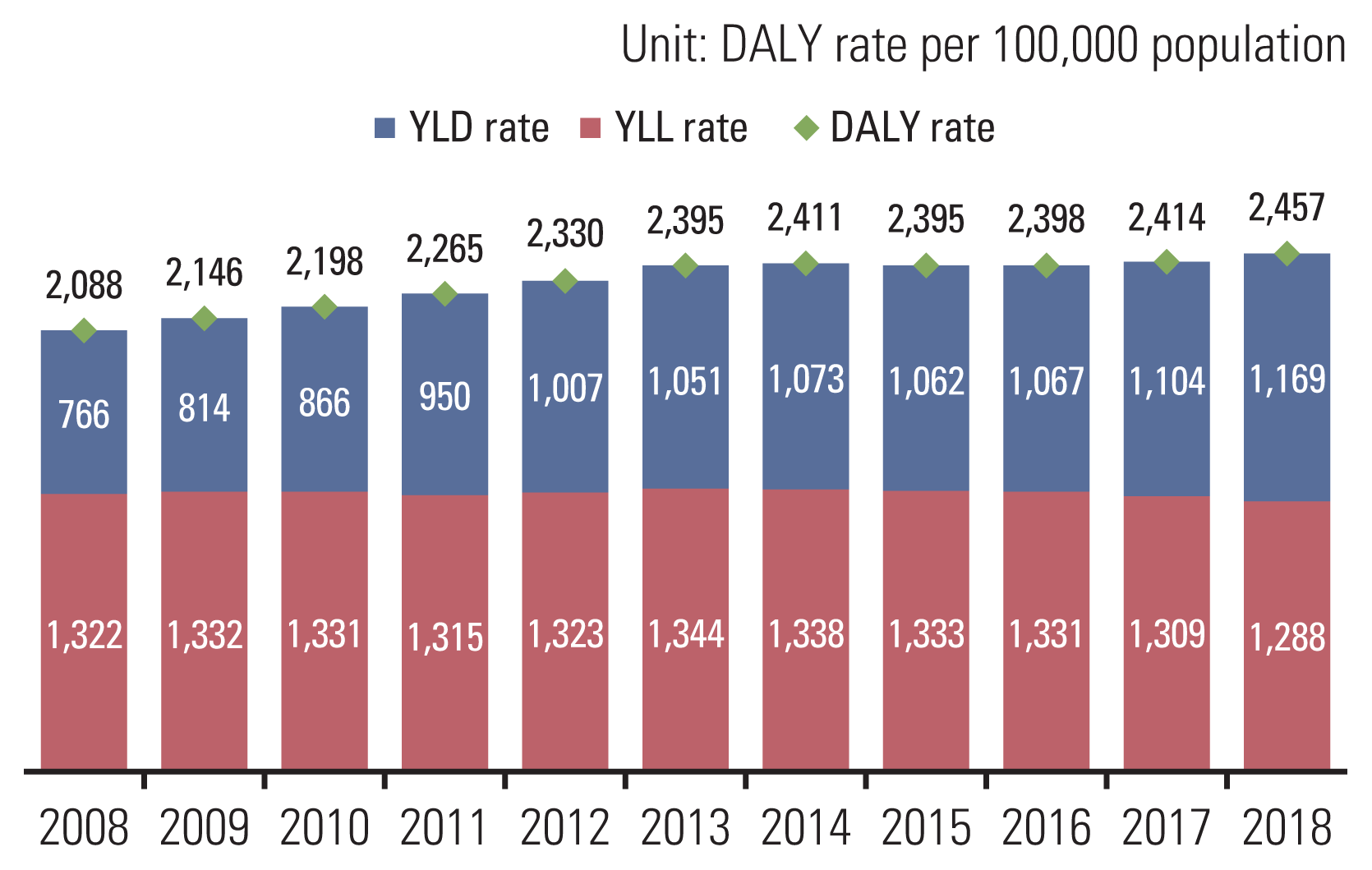

The leading causes of cancer DALYs for both sexes in 2018 were TBL cancers (n=349), stomach cancer (n=289), colon and rectum cancers (n=277), liver cancer (n=277), and breast cancer (n=241), which accounted for 58.3% of the total cancer burden in Korea. The proportion of the YLL in the DALY was the highest (≥ 70%) in pancreatic cancer, gallbladder and biliary tract cancer, brain and nervous system cancers, liver cancer, and TBL cancers, and the lowest in thyroid cancer and benign neoplasms of the brain and other parts of the central nervous system (< 10%) (
Fig. 2). There was a difference in the cancer ranking between males and females: in males, the DALY rate was the highest for TBL cancers (n=482), liver cancer (n=426), stomach cancer (n=381), colon and rectum cancers (n=328), and prostate cancer (n=183); in females, it was the highest for breast cancer (n=474), colon and rectum cancers (n=226), TBL cancers (n=218), stomach cancer (n=198), and thyroid cancer (n=162). The five major cancers accounted for 66.2% and 58.2% of the total cancer burden in males and females, respectively (
Table 1).
Fig. 2
DALYs by cancer site in Korea, 2018. DALY, disability-adjusted life year; YLD, year lived with disability; YLL, year of life lost.
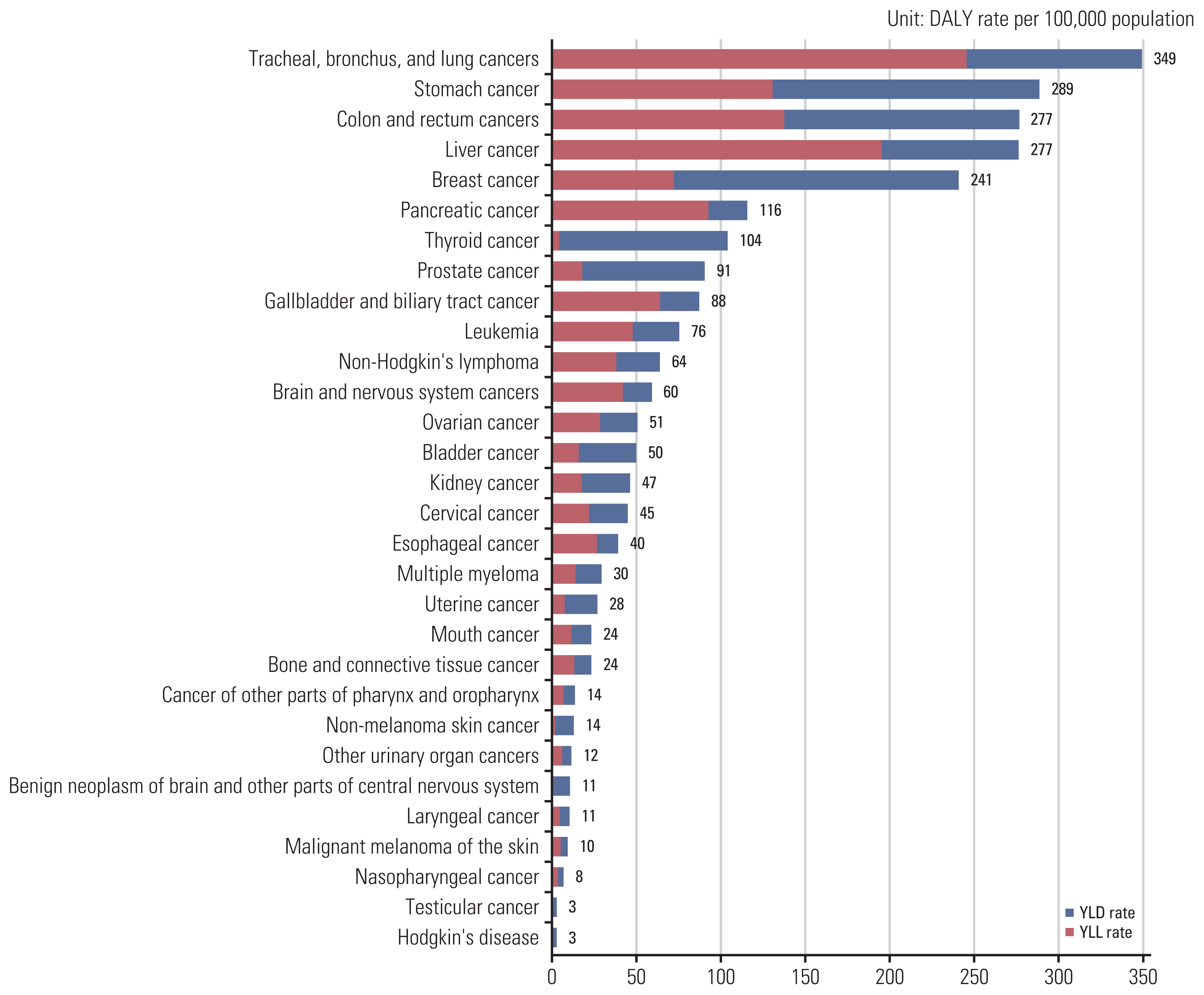

Table 1
DALYs (unit: DALY rate per 100,000 population) by cancer site and sex in Korea, 2018
|
Rank |
Men |
Women |
|
% of total DALY rates |
No. of DALYs |
DALY rate |
Cancer site |
Cancer site |
DALY rate |
No. of DALYs |
% of total DALY rates |
|
1 |
17.7 |
121,300 |
482 |
TBL cancers |
Breast cancer |
474 |
120,427 |
21.6 |
|
2 |
15.7 |
107,332 |
426 |
Liver cancer |
Colon and rectum cancers |
226 |
57,548 |
10.3 |
|
3 |
14.0 |
96,022 |
381 |
Stomach cancer |
TBL cancers |
218 |
55,505 |
9.9 |
|
4 |
12.1 |
82,668 |
328 |
Colon and rectum cancers |
Stomach cancer |
198 |
50,214 |
9.0 |
|
5 |
6.7 |
46,031 |
183 |
Prostate cancer |
Thyroid cancer |
162 |
41,072 |
7.4 |
|
6 |
4.8 |
32,548 |
129 |
Pancreatic cancer |
Liver cancer |
129 |
32,692 |
5.9 |
|
7 |
3.5 |
23,781 |
94 |
Gallbladder and biliary tract cancer |
Pancreatic cancer |
103 |
26,103 |
4.7 |
|
8 |
3.2 |
22,030 |
87 |
Leukemia |
Ovarian cancer |
102 |
25,898 |
4.6 |
|
9 |
3.0 |
20,478 |
81 |
Bladder cancer |
Cervical cancer |
90 |
22,926 |
4.1 |
|
10 |
2.8 |
19,106 |
76 |
Non-Hodgkin’s lymphoma |
Gallbladder and biliary tract cancer |
81 |
20,662 |
3.7 |
|
11 |
2.5 |
17,085 |
68 |
Esophageal cancer |
Leukemia |
64 |
16,301 |
2.9 |
|
12 |
2.4 |
16,251 |
65 |
Kidney cancer |
Brain and nervous system cancers |
56 |
14,279 |
2.6 |
|
13 |
2.3 |
15,926 |
63 |
Brain and nervous system cancers |
Uterine cancer |
55 |
13,939 |
2.5 |
|
14 |
1.7 |
11,741 |
47 |
Thyroid cancer |
Non-Hodgkin’s lymphoma |
53 |
13,509 |
2.4 |
|
15 |
1.2 |
8,016 |
32 |
Multiple myeloma |
Kidney cancer |
29 |
7,414 |
1.3 |
|
16 |
1.1 |
7,313 |
29 |
Mouth cancer |
Multiple myeloma |
28 |
7,188 |
1.3 |
|
17 |
1.0 |
6,846 |
27 |
Bone and connective tissue cancer |
Bone and connective tissue cancer |
20 |
5,148 |
0.9 |
|
18 |
0.9 |
6,029 |
24 |
Cancer of other part of pharynx and oropharynx |
Bladder cancer |
20 |
5,065 |
0.9 |
|
19 |
0.7 |
4,945 |
20 |
Laryngeal cancer |
Mouth cancer |
19 |
4,804 |
0.9 |
|
20 |
0.6 |
3,957 |
16 |
Other urinary organ cancers |
Non-melanoma skin cancer |
14 |
3,447 |
0.6 |
|
21 |
0.5 |
3,417 |
14 |
Non-melanoma skin cancer |
Benign neoplasm of brain and other parts of central nervous system |
13 |
3,304 |
0.6 |
|
22 |
0.4 |
2,808 |
11 |
Nasopharyngeal cancer |
Esophageal cancer |
12 |
3,029 |
0.5 |
|
23 |
0.4 |
2,530 |
10 |
Malignant melanoma of the skin |
Malignant melanoma of the skin |
10 |
2,478 |
0.4 |
|
24 |
0.3 |
2,329 |
9 |
Benign neoplasm of brain and other parts of central nervous system |
Other urinary organ cancers |
8 |
2,053 |
0.4 |
|
25 |
0.3 |
1,713 |
7 |
Testicular cancer |
Cancer of other part of pharynx and oropharynx |
4 |
1,049 |
0.2 |
|
26 |
0.2 |
1,610 |
6 |
Breast cancer |
Nasopharyngeal cancer |
4 |
992 |
0.2 |
|
27 |
0.2 |
1,058 |
4 |
Hodgkin’s disease |
Hodgkin’s disease |
3 |
645 |
0.1 |
|
28 |
0.0 |
- |
- |
Cervical cancer |
Laryngeal cancer |
2 |
570 |
0.1 |
|
29 |
0.0 |
- |
- |
Uterine cancer |
Prostate cancer |
- |
- |
0.0 |
|
30 |
0.0 |
- |
- |
Ovarian cancer |
Testicular cancer |
- |
- |
0.0 |

Trends over the past decade varied by cancer type. Between 2008 and 2018, the DALY rates for prostate cancer, multiple myeloma, testicular cancer, other urinary organ cancers, uterine cancer, and breast cancer significantly increased by more than 60%. Prostate cancer remained in the top 15 in 2008 but rose to the top eight in 2018. In contrast, the DALY rates of laryngeal, cervical, stomach, liver, and nasopharyngeal cancers decreased. Both the YLL and YLD rates decreased in cervical and laryngeal cancers. However, for stomach, liver, and nasopharyngeal cancers, the YLL rate decreased while the YLD rate increased, revealing that a decrease in the YLL rate contributed to a decrease in the DALY rate. As shown in
Fig. 3, the rankings of TBL cancers and colorectal cancer have risen over the past 10 years, while those of stomach and liver cancers have declined slightly.
Fig. 3
Cancer rankings by DALYs in 2018 and percentage change from 2008 to 2018 (unit: DALY rate per 100,000 population). Cancers are ordered by rank in 2018 and are linked to their ranking in 2008. Color refers to the change in DALY rate from 2008 to 2018: red signifies an increase of more than 60%, gray signifies an increase of less than 60%, and blue signifies a decrease. DALY, disability-adjusted life year; YLD, year lived with disability; YLL, year of life lost. Rankings are by DALY rate.
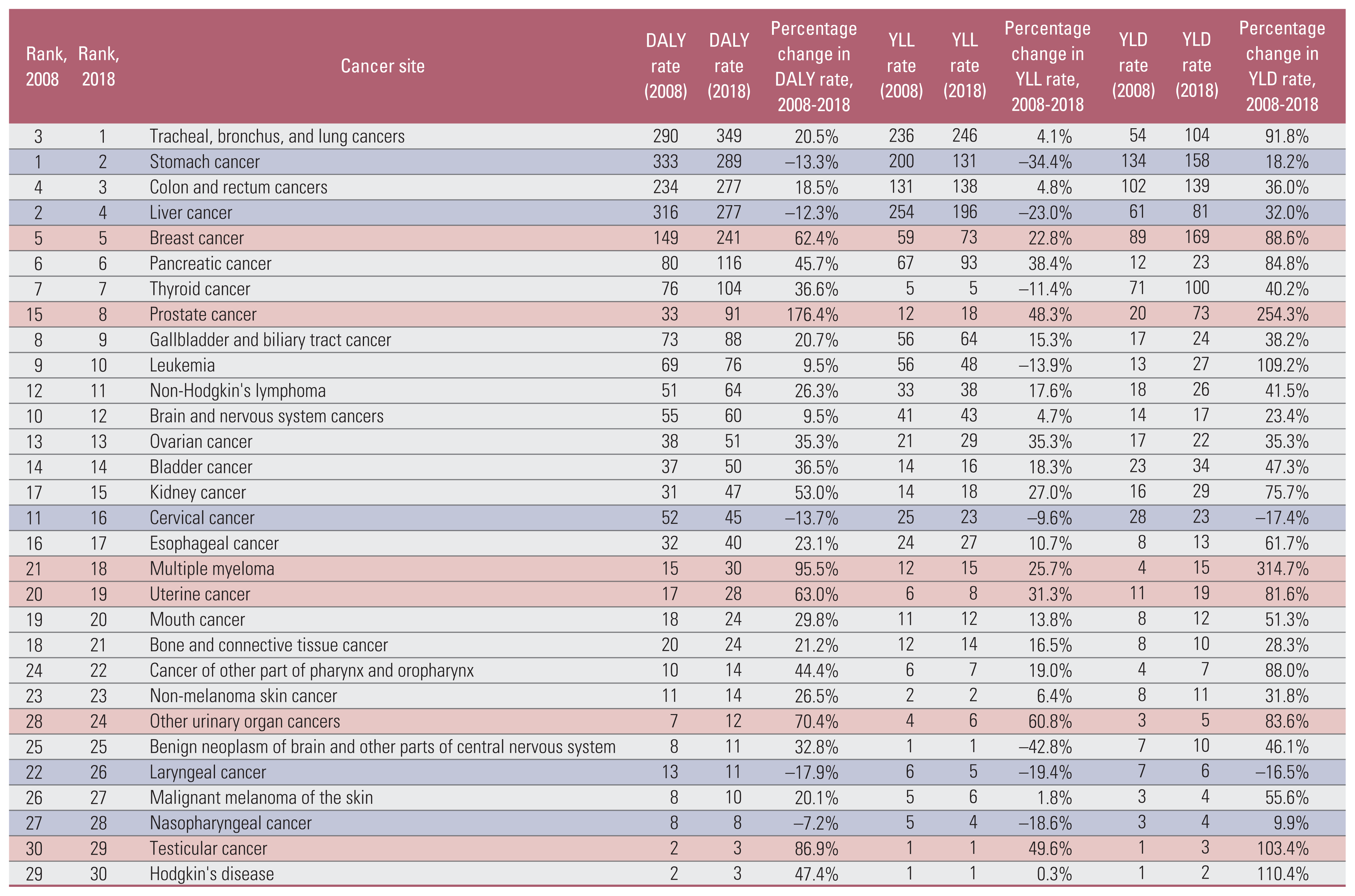

The distribution and difference in cancer burden by region were examined. The region with the highest DALY rate was Gunwi-gun, Gyeongsangbuk-do (n=4,312), which had a rate 2.61 times higher than that in the lowest region, Yeongtong-gu, Suwon-si, Gyeonggi-do (n=1,650). Further, the highest regional YLL rate (Gunwi-gun, Gyeongsangbuk-do; n=2,702) was 3.65 times higher than the lowest regional YLL rate (Yeongtong-gu, Suwon-si, Gyeonggi-do; n=740). Additionally, the highest regional YLD rate (Goesan-gun, Chungcheongbuk-do; n=1,787) was 1.96 times higher than the lowest regional YLD rate (Yeongtong-gu, Suwon-si, Gyeonggi-do; n=910). Regions with an overall low disease burden tended to be distributed in Seoul and the Gyeonggi Province. Furthermore, the gap in the burden of cancer death was larger than that of the cancer incidence (
Fig. 4).
Fig. 4
Cancer burden by region, 2018. (A) DALY rate per 100,000 population by region. (B) YLL rate per 100,000 population by region. (C) YLD rate per 100,000 population by region. DALY, disability-adjusted life year; YLD, year lived with disability; YLL, year of life lost.
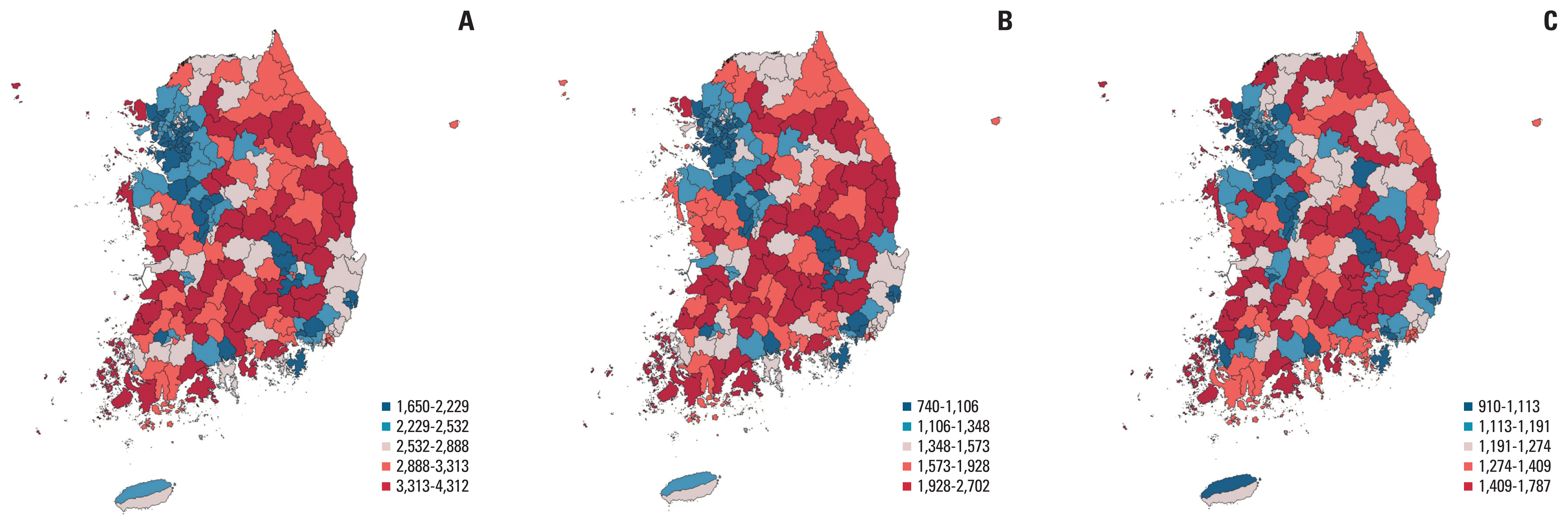

The gap in the DALY rate according to income level decreased from 2008 to 2012 and then increased. In 2008, the cancer DALY rate was 1.71 times higher in the Q1 group (lowest income level) than in the Q5 group (highest income level). This decreased to 1.60 times in 2012, but then increased again to 1.81 times in 2018. However, the difference in disease burden between the Q1 and Q2 groups was in the range of 1.38 to 1.47, indicating a significant difference between Q1 and the other groups. In addition, in terms of the rate of DALY rate increase over the past 10 years, the Q3–Q5 group showed an increase rate of around 15%, whereas the Q1 and Q2 groups showed relatively higher increase rates of 21.3% and 20.5%, respectively (
Fig. 5).
Fig. 5
Difference in cancer burden according to income level, 2018. DALY, disability-adjusted life year.
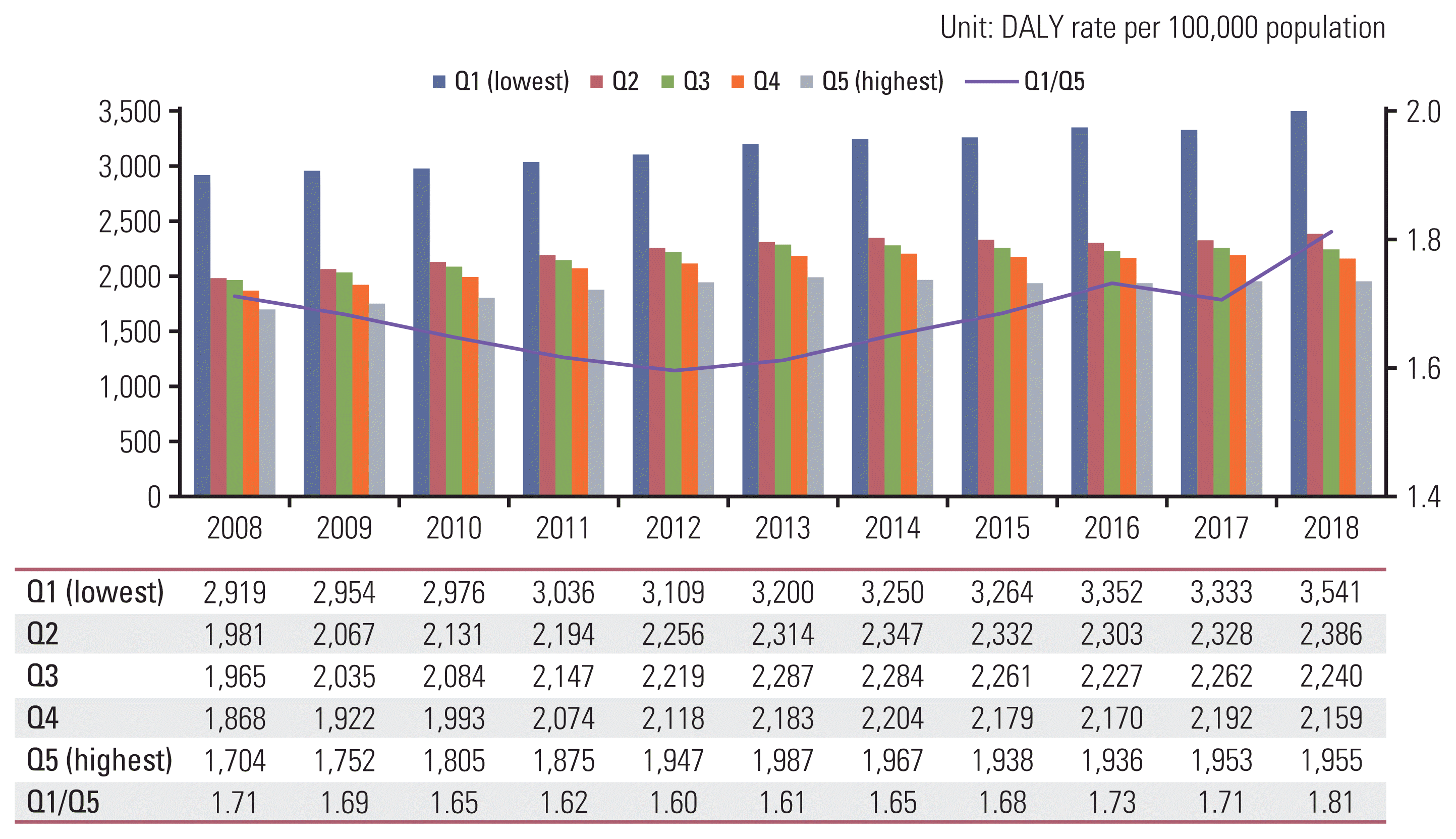

TBL cancers had the highest DALY rate among groups Q1 to Q5. In addition, the types of cancer ranked in the top five were the same. However, cancers with the second highest disease burden were stomach cancer in the Q2–Q4 groups, liver cancer in the Q1 group, and breast cancer in the Q5 group. Overall, the disease burden tended to decrease with increasing income level. Conversely, there were cases where the disease burden was greater in the high-income group than in the low-income group. For thyroid cancer, the DALY rate gradually increased as the income level increased, and the gap between Q1 and Q5 was 32 (Q1: 87, Q5: 119). In the case of prostate cancer, there was no constant increase according to income level, but among the groups, the DALY rate (107) was the highest in the Q5 group (
S1 Table).
Discussion
This study was conducted to quantify the burden of premature death and disability according to cancer site, sex, region, and income level by applying the GBD methodology to the situation in Korea. The cancer burden among Koreans has increased as a whole over the past decade. Further, the cancer burden due to death has decreased and the cancer burden due to disability has increased. Key findings from this study may help in understanding cancer patterns in Korea.
In 2008, the importance of preventing premature death was emphasized, as the YLL accounted for approximately 63% of the total DALY; since then, the YLD has steadily increased and YLL has decreased, resulting in a YLL:YLD ratio of 52:48 in 2018. This appears to reflect a situation in which advances in early detection, diagnosis, and treatment technologies for various cancers and improvements in cancer management have been effective in reducing the YLL. However, a reduction in the YLD rate due to primary prevention has not been adequately achieved, and as cancer survival rate is increasing, the overall cancer burden is still inevitably increasing. Continuous efforts are needed to reduce cancer mortality through early diagnosis, treatment, and prevention, with minimal sequelae. However, primary prevention efforts also need to be emphasized to reduce the cancer incidence through a reduction in cancer risk factors. In Korea, as interest and demand for specialized cancer treatment have increased, large cancer hospitals have been established and cancer treatments have diversified. Although treating cancer is naturally of importance, active investment in multidisciplinary research on the nature of cancer is essential. Furthermore, research focused on identifying cancer risk factors and understanding preventive effects should be actively pursued. It is necessary to develop cancer prevention practice guidelines that reflect such research results and strengthen publicity so that they can be put into practice in daily life. Above all else, there is a need for more specialized primary care services that can lead to overall lifestyle changes, such as appropriate physical activity and nutrition for cancer survivors and healthy people before the onset of cancer. The establishment and generalization of these primary medical services is very important for reducing the cancer incidence.
A decrease in the age-standardized mortality rate for many cancers in Korea over the past several decades can be observed from the main information annually published in the National Cancer Registry. Nevertheless, when examined by cancer site, the share of the YLL for pancreatic cancer, gallbladder and biliary tract cancer, brain and nervous system cancers, liver cancer, and TBL cancers was over 70%, suggesting that these cases reflect a poor prognosis after cancer diagnosis.
Regarding the cancer burden ranking results, the DALY rate was highest in the order of TBL cancers, stomach, colorectal, liver, and breast cancers, which was slightly different from the 2019 GBD order of lung, liver, stomach, colorectal, and pancreatic cancers [
6]. This seems to be due to differences in methodologies. In the GBD study, the burden of disease was calculated through an estimation based on published papers and the numerical values extracted therefrom. Epidemiological indicators collected by the Institute for Health Metrics and Evaluation, which served as data input in the GBD study, may not be the most useful and up-to-date information at the national level. In addition, multiple assumptions and methodological choices, often compromises, are required to integrate different types of information. Most importantly, there is a difference in the DALY measurement perspective. In the GBD study, a prevalence-based approach was applied. In contrast, in the present study, disease burden was measured using epidemiological indicators extracted from NHIS claims data, with information on the actual medical use of Koreans. In addition, the KNBD study, which is the basis of the present study, adopted an incidence-based approach that is useful for cohort-based data [
7].
TBL cancers in men and breast cancer in women were found to be major causes of the cancer burden, which is consistent with the ranking of cancer burden by sex published in the 2019 GBD study [
6]. Furthermore, a research team from the Alberta Department of Health in Canada analyzed premenopausal and postmenopausal breast cancer cases from 44 populations in 41 countries, including Asia, Europe, and the United States, and found that Korean women had the highest average annual growth rate of breast cancer [
15]. However, the breast cancer incidence rate is higher at a younger age in Korea than in Western countries. Contrary to the epidemiology of female breast cancer in the West, where the incidence rapidly increases in women in their 60s and 70s, the breast cancer incidence rate in Korean women is highest in women aged 45–50 years [
16]. The reasons for this increase in breast cancer incidence in young women are presumed to be early menarche, decreased breastfeeding, obesity, late marriage, and low fertility [
17–
19]. Although it is impossible to completely avoid situational factors with long-term exposure in women, such as the active entry of women into society and delays in marriage and childbirth, it is necessary to try to improve the prognosis by promoting self-examinations and managing individually controllable factors. On the other hand, TBL cancers have the highest cancer burden among all people and men, and the importance of management has been emphasized, as TBL cancers have ranked first in the country’s cancer mortality rate for the past 10 years. As can be seen from the results of the present study, with an YLL as high as 70%, TBL cancers are deadly, with a low survival rate. This is also supported by the 2018 National Cancer Registry statistics [
20], which reported the 5-year relative survival rate of lung cancer as 32.4%, representing the second poorest prognosis, after gallbladder and other biliary tract and pancreatic cancers. The increased recognition of the need for early TBL cancer screening was reflected by its addition to the national health screening list in July 2019 [
21]. The introduction and implementation of this TBL cancer screening program is expected to yield significantly improved survival rates.
The cancer burden trend over the past 10 years differed according to cancer site, and both the YLL and YLD decreased in laryngeal and cervical cancers. Laryngeal cancer, along with nasopharyngeal cancer, is a representative disease caused by smoking, and as the smoking rate of adults has continuously decreased over the last decade [
22], it can be inferred that reductions in the burden of laryngeal and nasopharyngeal cancers are an effect of the reduction in the smoking rate. In addition, the incidence of cervical cancer has gradually decreased since the human papillomavirus vaccine was introduced in Korea in 2006 [
23], and this effect may have reduced the burden of cervical cancer. In addition, cervical cancer screening is expected to further reduce the burden of cervical cancer through continuous efforts to improve screening rates, as this not only reduces mortality, but also lowers the incidence of cancer itself [
24] by detecting factors of cancer.
The decreases in the DALY rate for stomach and liver cancers were confirmed to be due to decreases in the YLL. For stomach cancer, the National Cancer Screening Program seems to be effective in reducing the death rate. A study by Jun et al. [
25] demonstrated that regular gastroscopy could reduce the risk of stomach cancer death by 81%. The effect of early screening for stomach cancer in reducing the risk of death was also reflected in the results of the present study. On the other hand, mortality rates in stomach and liver cancers are almost entirely attributable to modifiable risk factors [
26]. Thus, the decreases in the DALY rate for stomach and liver cancers may be attributed to improvements in the smoking rate [
22], which is a modifiable risk factor.
In contrast, in cancers for which the cause has not yet been clearly identified, such as prostate cancer, multiple myeloma, testicular cancer, other urinary organ cancers (including renal pelvic and ureteric orifice cancers), uterine cancer, and kidney cancer, the rate of increase in disease burden tended to exceed 50%. Although chemical substances and genetic factors have been mentioned as causes of these diseases, the causal relationship between these factors and disease onset has not been clearly identified. Therefore, research that can improve the understanding of the causes of these diseases, as well as the causes of this increase in disease burden, is needed.
Because NHIS claims data were used as the main data source in the present study, the health insurance premium variables and regional variables in the Qualification and Premium Database were used to identify differences in income level and regional cancer burden and its characteristics. According to the regional results, there were many regions with relatively low disease burden in Seoul and Gyeonggi-do, the metropolitan areas, which may reflect the differences in medical access and imbalances. Health disparities generally arise from a complex combination of socioeconomic, biological, behavioral, and structural barriers [
27], with lower socioeconomic groups more likely to engage, and persist, in unhealthy behaviors [
28]. In addition, these groups may have relatively fewer opportunities for early detection and timely treatment, and have a higher risk of serious comorbidities, than high socioeconomic groups [
29].
As revealed by the GBD study [
30], the cancer burden was high in the low-income group within the country, with a higher rate of increase over the past 10 years. In contrast, the burden of most cancers decreased as income level increased, with the exception of thyroid and prostate cancers, which had a higher disease burden in higher income groups. This is similar to the results of a previous study in which the screening prevalence, incidence rate, and postoperative complication rate of thyroid cancer were higher in the high-income group than in other groups [
31]. Controversy over the overdiagnosis of thyroid cancer has been growing in Korea since around 2014, and the claim that overdiagnosis is the cause of the rapid increase in thyroid cancer, based on the research published by Ahn et al. [
32], has spread throughout the world. Proponents of this claim have publicly pointed out problems with thyroid cancer screening and argued that the Korean government and medical community should refrain from overdiagnosis and take preventive measures. In other words, because thyroid cancer screening is an opportunistic health checkup, it may be affected by the financial ability of service users [
31]. On the other hand, other studies indicate that the risk of developing prostate cancer is increased in high socioeconomic groups [
33]. In Korea, as with thyroid cancer, it is presumed that this is the result of active participation by the high-income group in screening rather than an actual difference in cancer risk. However, since there are few studies that have identified a consistent cause in this regard, additional research is needed to determine the relationship between prostate cancer and income level. Finally, although the top five cancer types remained the same among all income groups, there were slight differences in the rankings. Thus, it is necessary to consider these results when setting cancer management priorities.
Combining the above results, there was a gap in the cancer burden according to sex, region, and income level. Additionally, there was a difference in the ranking of the cancer types accounting for the most cancer burden according to sex and income level. The findings from the present study can be used as a basis for establishing cancer management programs tailored to the characteristics of cancer burden by region or income level in the future. Most importantly, since the top five cancers (such as TBL and breast cancers) accounted for more than 50% of the cancer burden for both men and women, cancer management policies and health resource allocation that prioritize these cancers are required. In addition, it is necessary to identify rapidly increasing cancer types or specific issues by continuously monitoring the cancer burden, and efforts are needed to identify the causes and prepare countermeasures.
The present study has several limitations. Although the cancer burden was examined at various levels, its association with risk factors was not confirmed. It is necessary to quantify the attributable burden of risk factors such as smoking, drinking, and obesity, which are generally identified as being related to cancer. Because the frequency and level of exposure and the dangerousness of a risk factor may differ by age group, income level, etc., future studies should evaluate the attributable burden by various subgroups to provide useful evidence for cancer management. Another limitation is the uncertainty of the duration of each cancer. Although we used DisMod-II to estimate the duration of each cancer, it does not reflect differences in the duration of the disease according to the healthcare environment and the country’s level of development. In the future, it is necessary to develop and establish a methodology that can directly estimate the duration of each disease using real-world data, including information on actual medical use in Korea. Finally, although the NHIS claims data is useful for examining the overall distribution and long-term trend of the cancer burden, it does not reflect non-used medical services, unmet needs for medical services, and misdiagnoses because it only covers cases diagnosed at medical institutions.
Our findings on the cancer burden provide valuable and quantitative data for the prioritization and evaluation of prevention strategies and implementation of cancer policies with a focus on cancer prevention and early diagnosis. Estimating the difference in cancer burden according to region and income level within a country can help elucidate the nature of the cancer burden and scale of the problem. In addition, the results of this study provide clues to understand the patterns in cause of cancer. Such understanding helps generating new hypothesis about its pathogenesis. However, in the case of carcinoma, the cause of which remains unknown despite its large cancer burden, it is necessary to continuously conduct research to determine its etiology and lay the foundation for prevention.



